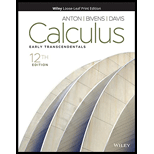
Prove: If
where
Want to see the full answer?
Check out a sample textbook solution
Chapter 13 Solutions
Calculus: Early Transcendentals, Enhanced Etext
Additional Math Textbook Solutions
Basic Business Statistics, Student Value Edition
Elementary Statistics: Picturing the World (7th Edition)
College Algebra (7th Edition)
Pre-Algebra Student Edition
Calculus: Early Transcendentals (2nd Edition)
Graphical Approach To College Algebra
- B. Let n > 3 be an odd number and f(a, y) = (x" + y")/". (a) Determine if f(x, y) is differentiable at (0,0). (b) Find all the points where f(a,y) is not differentiable. Justify your answer, (c) Find the unit vector(s) i € R? such that the directional derivative Daf(0,0) is minimum. (d) Compute or show that it does not exist. Əxðyarrow_forwarda) Find the directional derivative of f(x, y, z) = x²yz + 4xz² at (1, -2, 1) in the direction 2i - j - 2k.arrow_forwardMake itarrow_forward
- Please answer the followingarrow_forwarddz at the point (2, y, z) = (-2, 1,0) if z is a differentiable function of r and y related by the following Find equation: xy + xyz + 2 = sinarrow_forwardShow that the function given by f (x, y) = x² + 3xy is differentiable at every point in the plane. By using the definition.arrow_forward
- Let h(x, y) be a differentiable function and let (xo, yo) be a point in the domain of h. Also, let u be a unit vector. Then D- h(xo, yo) = -Du h(xo, yo). Hint: Your job is to show that two directional derivatives are related. First notice the two negative signs. One of them is the negative of a VECTOR. Start by computing the directional derivative on the LHS. Remember that for the dot product, a (-b) = (-a) b=-(ab).arrow_forward2. Find the directional derivative of f(x,y) = x cos y in the direction of v = 22, -1). A. (2 cos y + xsin y) (2 sin y - x cos y) B. √/5 C. 2 sinyxcos y D. cos yi - xsin yj E. 2 cos y - x sin yarrow_forwardCan you explain all the answers?arrow_forward
- f(x, y) = 3eª cos y, (a, b) = (0,7), and v = (3, 3). a. Calculate the directional derivative of f at the point (a, b) in the direction defined by 7. b. Find the direction at (a, b) in which the rate of change of f is greatest. c. Find the maximum rate of change. d. Fill in the blank: f decreases the most at (a, b) in the direction ofarrow_forwardLet f be a differentiable function of one variable. Show that all tangent planes to the surface z = yf(x/y) intersect in a common point.arrow_forwardf(x, y) = 5eª cos y, (a,b) = (0, 7), and v = a. Calculate the directional derivative of f at the point (a, b) in the direction defined by 7. & P b. Find the direction at (a, b) in which the rate of change of f is greatest. c. Find the maximum rate of change. =(5,3). d. Fill in the blank: f decreases the most at (a, b) in the direction ofarrow_forward
 Calculus: Early TranscendentalsCalculusISBN:9781285741550Author:James StewartPublisher:Cengage Learning
Calculus: Early TranscendentalsCalculusISBN:9781285741550Author:James StewartPublisher:Cengage Learning Thomas' Calculus (14th Edition)CalculusISBN:9780134438986Author:Joel R. Hass, Christopher E. Heil, Maurice D. WeirPublisher:PEARSON
Thomas' Calculus (14th Edition)CalculusISBN:9780134438986Author:Joel R. Hass, Christopher E. Heil, Maurice D. WeirPublisher:PEARSON Calculus: Early Transcendentals (3rd Edition)CalculusISBN:9780134763644Author:William L. Briggs, Lyle Cochran, Bernard Gillett, Eric SchulzPublisher:PEARSON
Calculus: Early Transcendentals (3rd Edition)CalculusISBN:9780134763644Author:William L. Briggs, Lyle Cochran, Bernard Gillett, Eric SchulzPublisher:PEARSON Calculus: Early TranscendentalsCalculusISBN:9781319050740Author:Jon Rogawski, Colin Adams, Robert FranzosaPublisher:W. H. Freeman
Calculus: Early TranscendentalsCalculusISBN:9781319050740Author:Jon Rogawski, Colin Adams, Robert FranzosaPublisher:W. H. Freeman
 Calculus: Early Transcendental FunctionsCalculusISBN:9781337552516Author:Ron Larson, Bruce H. EdwardsPublisher:Cengage Learning
Calculus: Early Transcendental FunctionsCalculusISBN:9781337552516Author:Ron Larson, Bruce H. EdwardsPublisher:Cengage Learning





